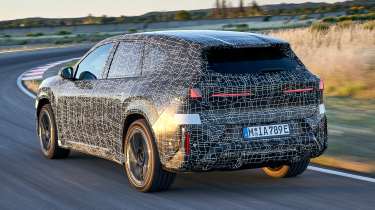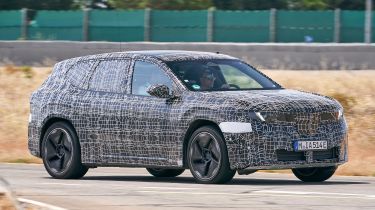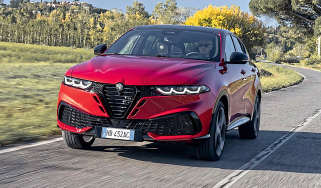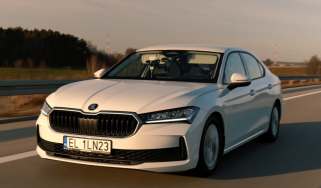New BMW iX3 prototype review: first Neue Klasse model is an exceptional EV
We get an early taste of the new all-electric BMW iX3 SUV ahead of its official arrival
Verdict
Based on our early drive, it seems that BMW has seized this pivotal opportunity to redefine its cars. We can’t wait to get our hands on the production iX3 later this year.
This is the BMW iX3, a “once-in-a-generation opportunity” to redefine its cars, reckons BMW. After years of hype, concept cars and technological teasers, Auto Express is standing among nine prototypes at BMW’s Miramas test facility in southern France. We’re going to be driving the breakthrough electric SUV on road, on track and become a guinea pig testing its autonomous capabilities.
It’s early morning but the warm, straw-coloured sun is heating up the black tape disguise as we squeeze the door handle and climb into the driver’s seat, covered to protect the design from prying eyes. There’s no hiding the cockpit’s biggest change however – the new Panoramic iDrive spanning pillar to windscreen pillar.
This displays key information in bitesize digital chunks at the top of the dashboard, and is totally configurable – apart from speed and range which sit immutably in the driver’s line of sight. I spy the battery is 97 per cent charged, with the iX3’s trip projecting a 653km (406-mile) range based on previous driving history. BMW says regular drivers will get maybe 100 miles more.
Used - available now
It’s a compliment to say that within a few kilometres the curved digital dashboard is no longer a novelty but accepted as a fresh, clear and attractive way to present familiar info. But it is distracting when the central BMW logo goes full Pixar Studios, morphing into a sunglasses-wearing animated blue ball offering to assist, accidentally triggered by co-pilot Christian Thalmeier uttering “BMW”.
There’s only one powertrain to test, the 50 xDrive, and furtive BMW is keeping the precise spec under wraps. What we do know is that the latest generation of BMW’s electrically excited synchronous motor spins the rear axle, while a smaller asynchronous unit powers the front – both are claimed to be lighter and more efficient than previous e-motors. They’re definitely punchy: I press the snappy throttle and the iX3 surges forward on a wave of torque, soundtracked by a layer of synthesised chords which build with our velocity.
The all-wheel-drive 50 cranks out more than 400 horsepower and 600Nm of torque, and cracks standstill to 62mph in less than 5.0 seconds. It feels addictively quick, smoothly feeding all that power to the bleached tarmac via a single-speed transmission and low-rolling-resistance Goodyear rubber.

The iX3 leads a new-generation of BMWs called the Neue Klasse. “It’s the start of a new era for BMW, as in the 1960s with the historical Neue Klasse,” says project leader Dr Mike Reichelt, referencing the clean-sheet, four-cylinder saloon family that saved BMW from bankruptcy. By the end of 2027, some 40 new and updated models will be launched, spreading its technology across the portfolio.
As the name suggests, the iX3 is the sister model to last year’s new combustion and hybrid-powered X3. Although it has much the same on-road footprint (albeit standing a little lower), the vehicle platform is completely different. Following rivals Tesla Model Y and BYD Sealion 7, the battery is a structural component, a first for BMW. And that triggers a new battery design, with cylindrical cells slotted straight into the pack, saving weight and space over stowing pouches of prismatic cells in frames. Energy density jumps 20 per cent, the engineers reckon.
We sail quietly along straights towards the craggy, limestone mountains, punctuated with fast roundabouts where the iX3’s steering feels light and responsive, swinging calmly through a curve that a Model Y might make feel edgy due to its razor-sharp steering.
Then comes a traditional French village where gnarled tree roots have extruded volcanoes in the tarmac. The iX3’s suspension oozes over them and surfs a massive speed bump I haplessly smack into at 30mph. There are no air springs, no adaptive damping, just big, 21-inch alloys and a passive suspension with hydraulic bump stops that doesn’t jar once on our 40-mile route, yet keeps the body nicely tied down with zero float.
The climb into the Alpilles is on narrow roads with a few hairpins and fast sweepers. A verbal request and the virtual assistant fires up Sport mode, with the digital panorama glowing red and a power/regen graphic appearing alongside a motor rev counter. And the Neue Klasse’s electronic nervous system, controlled by four superchips and all-new software for 20 times the computing power of today’s BMWs, gets primed for a more dynamic workout.

More torque is biased to the rear axle, and continually massaged to optimise traction, with the inside wheels slowed to pivot the BMW into corners. The front motor will react to quell any understeer. This drivetrain and chassis choreography all happens in the blink of an eye, far quicker than any mechanical system. BMW clunkily calls this dynamic superbrain the ‘heart of joy’ but it has a point: driving the iX3 puts a smile on your face in a way most electric cars don’t.
The steering retains its light feeling but it’s definitely sharper, hungrier off the dead-ahead position. You can really lean on the iX3’s front end, plunging into sweeping bends, feeling the car will hold its line. All the while the body rolls gently outwards, keeping the tyres suckered to the road as the rear end powers you through.
Naturally, the dynamic superbrain (the others are for infotainment, driver-assistance systems and general functions such as lighting and climate control) keeps a close eye on the brakes. There are low, medium and high settings but no paddles on the steering wheel to manually override them. Intervention in low is, well, low with the iX3 coasting along, so we switch to the high force of ‘B’ mode.
Co-pilot Thalmeier challenges me to guess the point where the motors’ regenerative braking blends into the friction brakes. Unlike in a Volkswagen ID.7 Tourer for example, the iX3’s braking is so smooth it’s typically indecipherable. BMW reckons typical drivers will benefit from regenerative braking in a staggering 95 per cent of decelerations – and the system can even harvest energy when the anti-lock brakes kick in.
One-pedal driving isn’t my usual EV preference but BMW has beautifully tuned the iX3’s ‘B’ mode. The accelerator has this delightful springy and linear response, and when you lift, the car brakes in keeping with your touch, either a light easing of pressure or a more urgent release. I feel like a virtuoso conducting an orchestra.
There’s no autoroute testing so we won’t get a handle on cruising refinement at this early stage but the iX3’s trip calculated we managed 3.5 miles per kWh, suggesting the BMW is going to be very competitive on economy.

And it should be quick to refuel, thanks to its 800-volt electric architecture (double a typical Tesla’s). Standing around at a 400kW DC charger is many a petrol-car driver’s nightmare but in just 10 minutes, we watch the iX3 guzzle 414km (257 miles). Charging from 10 to 80 per cent will take closer to 30 minutes on the UK’s lower-voltage chargers but when the infrastructure improves, the iX3 will be ready.
And then it’s time to drain the battery on Miramas’s handling loops. One section sticks in my mind: hard on the brakes to dart into a tight left, instantly followed by a hard right blasting out with as much power as you dare. Most EVs would wallow horribly as the high mass tries to shift direction, but the iX3 brakes, turns in and powers out with a directness and lightness that feels like alchemy.
BMW won’t confirm whether the iX3 suffers the 2-tonne excess hampering every e-SUV: it probably does but just doesn’t feel like it. Any weight advantage certainly doesn’t come from scrimping on space: the rear seats are blessed with the bigger X5’s legroom and the boot is comparable to an X3’s. And beneath that disguise lurks a design that’s very similar to the Vision Neue Klasse X concept, down to narrow kidney grilles within a horizontal bar that evoke the original Neue Klasse’s sharky nose.
The production SUV – and its spec – will be revealed at the Munich auto show in September, with UK deliveries likely in early 2026 priced from around £60,000. An electric saloon to replace the 3 Series won’t be far behind, as the tech spreads its wings.
All of which bodes well for next-generation BMWs. Panoramic iDrive isn’t revolutionary but it’s a great execution and will get fitted to cars such as the 5 Series at facelift time. But it’s in dynamic ability that the iX3 feels a cut above rivals. The deft steering and smooth braking are great, the supple suspension and splendid ride comfort even more outstanding.
Electric SUVs are typically all sledgehammer speed and no finesse. That ability to feel light – even when it isn’t – makes the iX3 an exceptional EV. To misquote Milan Kundera, a car blessed with the unbelievable lightness of being.
Click here to buy a used BMW iX3 with our Find A Car service.
Deals on the BMW iX3's rivals











